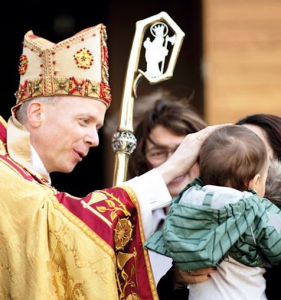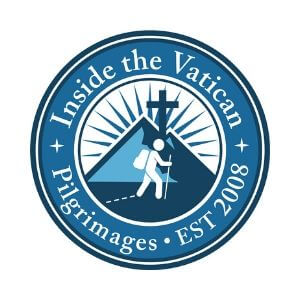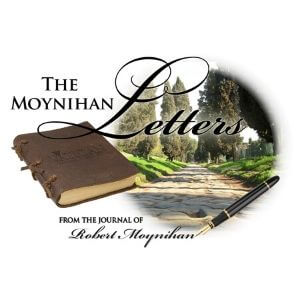“A bishop is but a link in a long, long chain which goes by the name of ‘tradition’… He looks back with attention, gratitude and grace to receive what is handed on to him; he looks forward expectantly, wishing to convey, undiminished, the treasure with which he has been momentarily entrusted.” —Bishop Eric Varden, 47, of Trondheim, Norway, commenting recently on the motu proprio issued on July 16, 2021, by Pope Francis, Traditionis custodes (“Of tradition the custodians” or, more colloquially, “The custodians of tradition”). The article has just been republished by Vaticanist Sandro Magister on his blog at this link, and the entire thoughtful essay is also republished below
“What he (Pope Pius XII) told him (Archbishop Giovanni Maria Montini, later Pope Paul VI, when Pius made Montini archbishop of Milan in 1954) was: go and pastor your variegated, scattered flock; find words and gestures they are apt to understand, but do not compromise; have confidence that the deposit entrusted to you from of old will contain the germ of answers you need to address the questions of today; live out of that deposit, dig into it, and deeply.” —Bishop Eric Varden, ibid.
Letter #129, 2021, Wednesday, October 6: Tradition
The idea of what it means to be a “guardian of tradition” continues to occupy my mind.
We just reflected on the meaning of this term for three days in a very successful conference/retreat to launch our new Unitas initiative in the Shenandoah Valley in Virginia.
About 45 people from around the United States met from Sunday through Tuesday (October 3, 4 and 5) at the San Damiano Retreat Center of the Archdiocese of Arlington, not too far from Christendom College in Front Royal, where a great gothic-style church called Christ the King Chapel is rising alongside of Route 66 under the driving inspiration of another “guardian of tradition,” Dr. Timothy O’Donnell, Christendom’s president for 30 years. (We visited the still-unfinished chapel.)
We kindly received a video of support from Metropolitan Hilarion Alfeyev of the Russian Orthodox Patriarchate of Moscow, with whom we have been collaborating for more than 15 years.
Essentially, we pledged to begin anew a 35-year-old work to try to:
(1) “build bridges” between Catholics and Orthodox, and to try to
(2) “build bridges” between sometimes conflicting groups or lobbies within our Catholic Church (also through these letters), and, in general, in the modern secular (oriented toward what is secular, not toward what is sacred) culture, to
(3) “build bridges” between the human soul and God — to defend and promote the truth that the soul of each human bring has great dignity, being in truth made “in the image and likeness of God,” and a great destiny.
So what will Unitas do?
Build up, if we can, that unity that is referred to in the first of the four words of the Creed which refer to the characteristics of the Church: one, holy, catholic and apostolic.
This “one” means “united” — one throughout the world, one throughout time, one throughout the past, one now, one throughout the future, one in faith, one in baptism into Christ, one in belief in Him as the redeemer of the world.
And so, while working for ecclesial unity — even reunion of the Catholics and orthodox — we will try also to “evangelize the culture” and support the renewed discovery of our God-given dignity in every way possible, so that we, with others, may do our part to “restore all things in Christ.”
We took our keynote phrase, “Unitas: Come, Rebuild My Church,” from the words spoken by Christ from the cross of San Damiano in Assisi in about 1206 to a young St. Francis of Assisi, who was praying in a crumbling chapel to discern the path his life might take.
“Francis,” he heard the Lord say, “Come, rebuild my Church, which, as you can clearly see, is falling into ruins.”
Francis was struck to his core.
At first he thought, “Ah, I will find a wheelbarrow, and gather stones, and rebuild this crumbling chapel.” And he did that for some time.
Only slowly did he come to realize that his task was far greater, that it involved renewing and re-positioning all of the “living stones” which make up the Church of God.
A movement of spiritual renewal.
A movement of renewed spiritual life.
So if the first tasks we face — or so it seems to us — are to overcome open ecclesial wounds, divisions which have separated us for decades, centuries, even millennia, to become more nearly “one” again after profound disagreements and schisms, the entire project must also and always be rooted in a type of spiritual renewal which must weigh what is good from all that the present time proposes, keeping that which is good while rejecting what is not good, and must hold fast always to what is central to our tradition, so that we ourselves may become one more link in a long chain to hand on to the future what we have received, preserved often at great cost.
So we have launched the Unitas initiative. It was a wonderful three days, a special time of grace, especially in the Masses celebrated by Father Tom Shepanzyk of St. John the Baptist Church in Front Royal, and Father Paul M. Grankauskas of St. Bridget of Ireland Catholic Church in Berryville, Virginia. Both men gave inspired homilies which touched the hearts of all of us.
If you would like to join us in this work, we would be grateful if you would accompany us and support us on the way. The road ahead is long and difficult, and it would be helpful to have companions on the journey.
Please join us live on Friday, as we chat with Dr. Peter Kwasniewski this Friday, October 8, 2021, at 1:00 p.m. Eastern time.
Dr. Kwasniewski is a respected expert on the Catholic liturgy and one of the most engaging and thoughtful scholars of the history of the Mass. If you would like to understand the Novus Ordo Mass, the old Latin Mass, the passage from one Mass to the other, this chat may be of great interest to you. We encourage you to join on Friday at 1 p.m. Eastern time. (We do plan to also record the conversation and make the tape of the conversation available on the internet. We will keep you posted on where and when to find the video tapes.)
This Zoom event is live and you will have an opportunity to join the conversation. Click the button below to register for free.
How to Treasure Tradition Today: A Lesson from Norway (link)
by Sandro Magister, one of the leading Italian observers of Vatican affairs
In his free-wheeling chat on September 13 with the Jesuits of Slovakia, Pope Francis had a lot to say. Among other things, he identified the greatest “evil of the Church at this moment” in the “ideology of turning back.”
The pope did not use the word “tradition.” But it is there that according to him the “perversion” of “rigidity” lurks. One need only look at the derisive title, “Traditionis custodes,” of the motu proprio with which last July 16 he intended to decree the end of the Mass in the ancient Roman rite, addressing the bishops as “guardians of tradition” precisely to impose on them rules that tear tradition to pieces.
Then, in practice, the motu proprio did not have the effect he hoped for. Most of the bishops have let things go on as before, especially in France and the United States, the two countries where celebration in the ancient rite is most widespread. For many, the idea of tradition theorized and lived by Benedict XVI continues to apply, according to which the old and the new, in the Church, can and must be “mutually enriching.”
But if a bishop were to take seriously the epithet of “traditionis custos” that Francis has saddled him with, what positive lesson could he draw from this?
There is one bishop who has tried, and has written about it, first on September 15 in the progressive English Catholic magazine “The Tablet” and then on his blog, coramfratribus.com. Authorized by both, Settimo Cielo reproduces the full text below in several languages.

The bishop’s name is Erik Varden (pictured above). A 47-year-old Norwegian, he converted to Catholicism as a young man, studied theology and philosophy in Cambridge, became a Cistercian monk of the strict observance, a Trappist, and was abbot, in England, of the Abbey of Mount Saint Bernard in Leicestershire. He also studied in Rome at the Pontifical Oriental Institute and taught for a few years at the Pontifical Athenaeum of Saint Anselm.
Pope Francis appointed him bishop of Trondheim, and on October 3 2020 he received sacred ordination in the city’s cathedral, the first since the Protestant Reformation. Out of a population of 700 thousand people, in a vast territory, Catholics are 16,000, mostly immigrants from numerous countries of the world, as in a mission land.
Varden is also a musician and lover of Gregorian chant. At the Easter vigil of 2011 it was he who sang the Exultet in St. Peter’s Basilica. In 2018 he published a book with Bloomsbury that already in the title suggests the reference to tradition: “Shattering of Loneliness. On Christian Remembrance.”
Here is his learned and original reading of tradition, with at times surprising references to the patriarch Isaac, to Giovanni Battista Montini, archbishop of Milan, and above all to Pontian and Hippolytus, the first Pope who resigned in history and his opponent, one an innovator and the other a traditionalist, reconciled in martyrdom and holiness.
“TRADITIONIS CUSTODIA”
by Bishop Erik Varden
Lumen Gentium (“The light of the nations”), the Second Vatican Council’s splendid Constitution on the Church, describes the office of a bishop by means of beautiful titles.
If you happen to be a bishop, they are also pretty intimidating.
You are then, you are told, to be a “shepherd of the Church” (n. 18), a “successor of the Apostles” (n. 18), “the visible principle and foundation of unity” in your diocese (n. 23), “the steward of the grace of the supreme priesthood” (n. 26) and much else besides.
In a recent motu proprio, the Holy Father stressed a further epithet. He reminded us that a bishop is “traditionis custos,” a custodian of tradition.
For that definition, I, a novice bishop, am grateful.
***
It is tempting, when appointed to such an office, to think that much depends on you. Pope Francis reminds us that this is not the case.
A bishop is but a link in a long, long chain which goes by by the name of “tradition.”
This word is a noun of agency. In Latin, “traditio” indicates the act of passing something on.
A bishop charged with custodianship of tradition must ensure that transmission continues.
He looks back with attention, gratitude and grace to receive what is handed on to him; he looks forward expectantly, wishing to convey, undiminished, the treasure with which he has been momentarily entrusted.
“Undiminished” is not a synonym for “unchanged;” still, caution is called for.
I must not reduce universal patrimony to a product merely of my preference.
When the Council urged us, with what I’d presume to call Cistercian emphasis, to return to the sources, it was with a view to restoring fullness where particular choices had issued in constraint and made broad places narrow.
To live, work, and pray as the Council taught is to be like Isaac, that mysterious patriarch. He left few words for the record, worked few monumental acts.
Still, his example is notable.
Unconcerned to leave a mark of his own, “Isaac dug again the wells of water which had been dug in the days of Abraham his father; for the Philistines had stopped them after the death of Abraham; and he gave them the names which his father had given them” (Genesis 26:18).
Restoring access to paternal wells, he made sure his children could drink.
“Depositum custodi”
I think often of an incident in the life of Giovanni Battista Montini, later Pope, now Saint, Paul VI.
Having been appointed to the see of Milan, Montini had an audience with Pius XII.
As the two men took leave, the ageing, ailing Pope gave the new archbishop this counsel: “Depositum custodi” (“Guard the deposit of the faith”).
It is a phrase of substance.
The notion of the “depositum fidei” (“deposit if the faith”) is ancient.
It refers to the fullness of faith contained in both Scripture and Tradition; it stands for that without which Christianity would not be itself.
It is not a static notion.
The deposit will find ever new ways of expressing itself.
It speaks many languages.
It is able to assume different cultural forms.
To find its most authentically “christophorous” articulation here and now is a challenge for each generation of believers.
What matters is this: not to reduce it to less than itself.
Montini succeeded Cardinal (Alfredo Ildefonso) Schuster to the see of Milan in 1954.
It was a time of turmoil and uncertainty.
Of this Pius XII was more aware than most.
He did not tell Montini to be a broken record, to keep mouthing old truths in old ways.
He knew that searching intellect, that sensitive priest, too well.
What he told him was: go and pastor your variegated, scattered flock; find words and gestures they are apt to understand, but do not compromise; have confidence that the deposit entrusted to you from of old will contain the germ of answers you need to address the questions of today; live out of that deposit, dig into it, and deeply.
This was how Montini explained the Pope’s words in his inaugural address, which pointed to the millennial tradition of the Church as a source of ever new relevance and originality.
These days there is a tendency abroad that seeks to reduce “tradition” to a term of partisanship, something one can be either for or against.
It makes no sense.
The moment I look upon “tradition” as an object, a possession within my grasp (whether to reject or jealously to preserve it), I reduce a living process to a thing.
I assign myself the task of an antiquarian charged with granting or rejecting preservation orders.
That is quite different from being a custodian.
There is a beautiful line in the Church’s compline hymn.
It asks the Maker of all things “ut solita clementia sis præsul ad custodiam.” (“Before the end of day, Creator of the world we pray, that with your desired favor, you would be our protector and guard“).
Custody is a function of constancy in clemency.
To exercise it is no not to lag behind but to go ahead.
The word “praesul,” often rendered “protector,” literally means “someone who leaps or dances in front,” like David before the Ark (2 Sam 6:14ff).
There must be humble energy in custodianship, and grateful joy.
Careful of what lies behind, it makes us fit to move forward.
It goes without saying that all will not always agree on how to negotiate tradition.
There is room for respectful, constructive dispute.
There always has been.
Part of what makes the Church catholic is its capacity to sustain tension, to wait for apparent antitheses to be resolved — by grace, in charity, not by compromise — in synthesis.
We struggle with this aspect of Catholicism today.
Why?
Partly because the pace of life has made us too impatient to give any process at all the time it needs to work.
Partly because we fall prey to the peculiarly twenty-first-century, self-aggrandising delusion which assumes that our times are categorically different from all other times and so ever call for categorically new measures.
We could do with re-reading Ecclesiastes.
And with remembering a lesson or two from Church history.
One such was offered us recently by the liturgical calendar.
On 13 August we had the option of keeping the memoria of Sts Pontian and Hippolytus.
Not all Catholics will have a spontaneous devotion to these two.
It is a pity.
They have a great deal to teach us.
Pontian was bishop of Rome 230-35 A.D.
The Church’s outward position then was fragile, imperial tolerance intermittent.
Within, it was riven by disagreements to do with Origen.
That incomparable theologian had been condemned by two Alexandrian councils whose edicts Pontian approved.
There was strife, too, about forgiveness of sin.
Are there people irreparably beyond the pale on account of acts they have committed, whether of moral failing or connected with apostasy?
The Popes increasingly envisaged reconciliation to communion through penitence.
This policy sparked strong responses.
Chief among critics was the priest Hippolytus.
Philippe Levillain’s distinguished dictionary of papal history refers to him as a “traditionalist.”
[Editor’s Note: !]
Hippolytus was soaked in Greek thought.
Origen, who heard him preach, admired him.
Hippolytus deplored what he saw as lax, thoughtless attitudes on the part of the hierarchical Church.
Gradually he mobilised an alternative communion.
Whether he was in fact, as is sometimes claimed, an “antipope” remains a moot point; but he was certainly a thorn in the side of Rome’s legitimate bishop.
When, in March 235 A.D., Maximinus the Thracian acceded to the imperial throne, he wished to undermine the Christian presence in Rome.
A convenient way to do so, he thought, would be to deprive the Church of its heads.
He recognised two: Pontian and Hippolytus.
[Editor’s Note: !!]
So he had them both arrested and packed off to hard labour in the Sardinian mines.
There, the two old opponents were reconciled.
[Editor’s note: !!!]
Both recognised the other’s Christian sincerity notwithstanding differing opinions on particular matters.
Pontian, sensing he would not live long on account of the treatment meted out to him, abdicated his office, the first Pope to do so.
He died in October 235.
Hippolytus died not long after.
Within a year or two Pope Fabian had their bodies brought back to Rome.
The Church honours both men as martyrs: we celebrate them with red vestments, within a single feast, as if the testimony of one would be incomplete without the other.
[Editor’s note: !!!!]
The collect for the feast of Sts Pontian and Hippolytus offers wholesome food for meditation, perhaps also for self-examination:
“Patientia pretiosa iustorum tuæ nobis, Domine, quæsumus, affectum dilectionis accumulet, et in cordibus nostris sacræ fidei semper exerceat firmitatem.”
“May the precious patience [a word within which the Latin root ‘passio’ is embedded] of the righteous, Lord, increase in us a heartfelt attachment to your love; and may it at all times exercise our hearts to firmness in holy faith.”
[End, important and thoughtful essay on tradition by Bishop Eric Varden of Trondheim, Norway]
We ask you to support Urbi et Orbi Communications with a small or large contribution, at this difficult time, in order…
(1) to keep Inside the Vatican Magazine (which we have published since its founding in 1993, 28 years ago) independent and comprehensive… a unique lens into the Church and the World. Now available to you digitally as well as in print!
(2) to ensure that Inside the Vatican Pilgrimages can keep creating encounters for you with the Heart of the Churches, the homes of the Saints, and the Living Stones — the people — of whom the Church is built. Now offering you virtual pilgrimages from your home computer! (see below for more information)
(3) to help to bring the Churches closer together by “Building Bridges” to heal the schisms of the Church — East and West — through our non-profit Urbi et Orbi Communications.
(4) to sustain our occasional news and editorial emails, The Moynihan Letters, bringing the latest valuable information and insight like no other source to thousands of readers around the world.
Please, do not overlook this opportunity to work with us. We very much appreciate your gift, whether small or large.
Thank you.
In Christ,

Dr. Robert Moynihan and the rest of the Urbi et Orbi Team









Facebook Comments